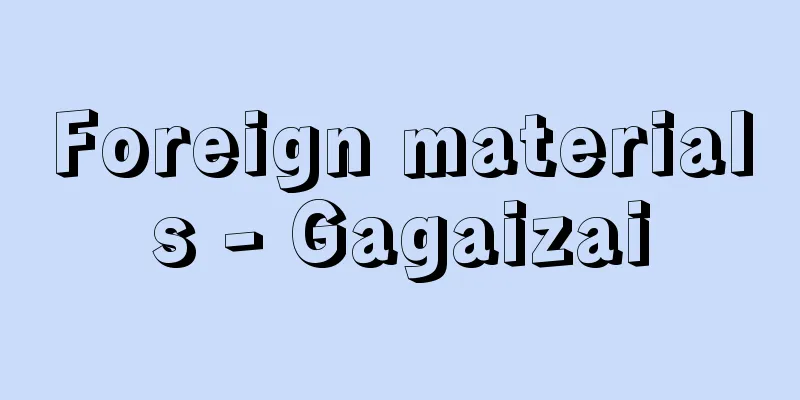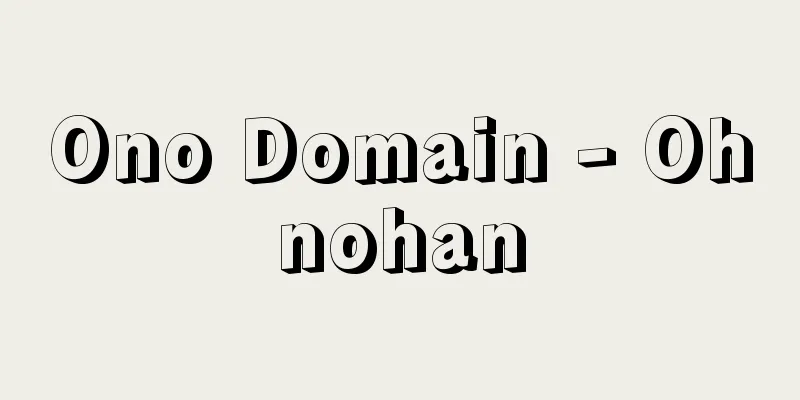Foreign materials - Gagaizai

|
A general term for wood and wood products imported from overseas. Gaizai is a term unique to Japan, and is known internationally as 'imported wood.' Until the Second World War, Japan referred to the domestic region as 'naichi' (homeland) and overseas as 'gaiichi' (foreign land), and these terms were applied to imported wood. Japan's history of importing foreign timber began in 1914 (Taisho 3) against the backdrop of the economic boom caused by World War I. The plywood industry was born in 1907 (Meiji 40), and sought out raw timber from Southeast Asian countries (lauan) to meet the sudden increase in demand for plywood during World War I. The paper and pulp industry expanded into Sakhalin, where coniferous forests are widespread, and began local production, while also importing pulp logs from Russia's Primorsky Krai and other areas. The lumber industry imported logs for lumber from the United States, where there are vast coniferous forests for lumber, from the Taisho period to the early Showa period. This lumber import from the United States continued for over 15 years, but was suspended in the mid-1930s when international scrutiny of Japan became stricter due to the Sino-Manchurian Incident and other events. As an alternative, the lumber industry took measures to switch to sourcing foreign raw timber from Southeast Asian countries. This import of foreign timber, mainly from the South Seas and North Seas (Russia), continued until the 1950s after World War II. After the Second World War, the full-scale import of foreign timber was started by the Cabinet decision of 1961 (Showa 36) "Emergency Measures to Stabilize Timber Prices" as a measure against the soaring timber prices that emerged during the period of rapid economic growth. The "Emergency Measures to Stabilize Timber Prices" proposed the liberalization of timber and pulp as a measure against timber prices that continued to soar at a rate that exceeded wholesale prices. Based on the Cabinet decision, the government abolished tariffs on coniferous logs, as well as North American hemlock and Douglas fir lumber products and pulp chips. At the same time, the government approached major general trading companies affiliated with the former zaibatsu conglomerates, which had been receiving preferential treatment in foreign currency allocations, and asked them to participate in the import of foreign timber, replacing the major timber wholesalers that had been responsible for the import of foreign timber up until that point, which also operated lumber businesses. The government also approached local governments and began port development projects, such as the construction and improvement of timber-only wharves, to handle large-scale imports of foreign timber. The liberalization of lumber and pulp, which began with the Cabinet decision on the "Emergency Measures to Stabilize Lumber Prices" in 1961, was codified in the "Basic Forestry Law" of 1964. This law established the policy guideline of "stabilizing lumber supply and demand and prices by promoting the fair and smooth import of foreign lumber." On the other hand, the major general trading companies, which received government participation in the import of foreign timber, formed individual alliances with large American timber companies headquartered on the West Coast of the United States, and took measures to ensure a stable supply of imported timber. This marked the start of full-scale imports of softwood timber from the North American continent, and led to a shift from imports of South Sea timber and North Sea timber to imports of American timber. The major general trading companies also played a major role in importing North Sea timber and South Sea timber, but in contrast to the import method for American timber, the major general trading companies expanded imports by investing directly in the producing countries, a method known as development imports. The major general trading companies formed chains of agents and major shippers (exporters) in the producing countries, and expanded imports by making large-scale capital investments, adopting a plantation-like development method. As a result, South Sea timber was imported at a relatively low price compared to other foreign timber, and this played a role in pushing down the price of foreign timber in competition with domestic timber. The import of foreign timber, which began in this way, combined with the capital strength of major general trading companies, led to a rapid increase in the volume of imports, raising the share of foreign timber in the timber supply. In 1961, when the liberalization of timber was decided by cabinet decision, the share of foreign timber was just under 20%, but eight years later in 1969, that share had exceeded 50%, surpassing the supply share of domestic timber. The supply share of foreign timber continued to increase year by year thereafter, rising to the 60% range in the mid-1970s and then further to the 70% range around 1980. Furthermore, imports of foreign timber, which had previously been centered on logs, have shifted significantly since the 1990s to imports of sawn timber and processed products. At the peak of imports in 1970, 77% of imports were in the form of logs and 23% in the form of finished products, meaning that nearly 80% of timber imports were in the form of logs (1972 edition of the Forestry White Paper). In contrast, according to the Forest and Forestry White Paper (2013 edition), in 2012 (Heisei 24), imports in the form of logs accounted for 10% and finished products for 90%. The main factor behind this major shift in imports of foreign timber from logs to finished products was the Japan-US Forest Products Consultation, which was held from the late 1980s to the early 1990s with the aim of easing economic friction between the two countries. The Japan-US Forest Products Consultation, which began in 1986, reached a number of agreements before finally reaching a final agreement in 1994. Tariff reduction talks continued until 1999, and it was agreed that tariffs on all wood products, mainly lumber and softwood plywood, would be reduced by an average of 51%. As a result, Japan's effective tariff rate on forest products was 1.7%, making it one of the countries with the lowest tariff rates, along with Canada, among the major countries. In addition, the series of Japan-US "agreements" also "agreed" to promote the import of North American-made two-by-four construction housing, and non-tariff barriers such as the Building Standards Act and JAS (Japanese Agricultural Standards) were revised. As a result, the import of highly processed two-by-four construction housing materials began in earnest. The shift from importing logs (raw materials) to importing processed products and then to importing highly processed products (finished products) will directly accelerate the foreignization of not only the lumber sector but also the housing market, which is the final consumer of timber, and will inevitably inflict further damage on domestic timber. The import status of foreign timber by type as of 2012 is as follows. The annual import volume (logs and products) was 50.79 million cubic meters, with foreign timber supply accounting for 72% of the total timber supply. The breakdown by timber type is American 26%, South Seas 12%, European 11%, North Seas 4%, and other 47%. The breakdown by country is Australian 10%, Chilean 10%, New Zealand 5%, Chinese 5%, and African and other 17% (Forestry and Forestry White Paper 2013 edition). [Yamagishi Kiyotaka] "History of the Forestry Cooperative System, 4 volumes compiled by the National Federation of Forestry Cooperatives Forestry Cooperative System History Compilation Committee (1973, National Federation of Forestry Cooperatives)" ▽ "Foreign Timber: Its Current State and Outlook, by Ando Yoshitomo (1974, Japan Forestry Research Council)" ▽ "Practical Knowledge of Wood, by Uemura Takeshi, 3rd Edition (1988, Toyo Keizai Inc.)" ▽ "Economics of the Forest Environment, by Yamagishi Kiyotaka (2001, Shin Nihon Shuppansha)" ▽ "Forestry Agency, ed., Forest and Forestry White Paper, various years' editions (Agriculture and Forestry Statistics Association)" [Reference item] | | |Source: Shogakukan Encyclopedia Nipponica About Encyclopedia Nipponica Information | Legend |
|
海外から輸入された木材・木製品の総称。外材は日本特有の用語であり、国際的には輸入木材とよばれる。第二次世界大戦前までは、日本は国内を内地、国外を外地とよんできたが、その呼び名が輸入木材につけられたものである。 日本の外材輸入の歴史は、1914年(大正3)の第一次世界大戦の景気高揚を背景に始まる。合板工業は、1907年(明治40)に生まれ、第一次世界大戦の合板需要の急増に対処するために原木の入手を東南アジア諸国の南洋材(ラワン)に求めた。紙・パルプ産業は、針葉樹林が広く存在する樺太(からふと)に進出し現地生産を開始する一方、ロシア沿海州などからパルプ原木の輸入も行った。製材業界は、製材用の針葉樹林が広大な規模で存在するアメリカを対象に、大正期から昭和初期にかけて製材用丸太の輸入を行った。このアメリカからの木材輸入は15年あまりにわたって行われたが、中国・満州事変などで日本に対する国際社会の監視が厳しくなる1930年代中ごろに中断された。その代替として製材業界は、外材原木の入手を東南アジアの南洋材に切り替える措置をとった。この南洋材と北洋材(ロシア)を中心とする外材輸入は、第二次世界大戦後の1950年代まで継続された。 第二次世界大戦後の本格的な外材輸入は、高度経済成長下で発現した木材価格の高騰対策として閣議決定された1961年(昭和36)の「木材価格安定緊急対策」によってである。「木材価格安定緊急対策」は、卸売物価を超える勢いで高騰を続ける木材価格対策として、木材、パルプの自由化を提示したものであった。閣議決定をもとに政府は、針葉樹丸太の関税撤廃をはじめ北アメリカ産のベイツガ、ベイマツ製材品ならびにパルプ用チップ材の関税撤廃を行った。同時に、それまで外材輸入を担ってきた製材業兼営の大手木材問屋に替えて、外貨割り当ての優遇を受けていた旧財閥系の大手総合商社などに働きかけて外材輸入への参画を求めた。また、政府は、地方自治体にも働きかけ、大規模な外材輸入を行うための木材専用埠頭(ふとう)の整備、新設などの港湾整備事業を開始した。この1961年の「木材価格緊急安定対策」の閣議決定で開始された木材、パルプの自由化措置は、1964年の「林業基本法」によって法制化される。そこでは、「外材輸入の適正円滑化で木材需給・価格の安定を図る」ことを政策指針に位置づけたのである。 他方、政府から外材輸入への参画を受けた大手総合商社は、外材輸入を行うにあたって、アメリカ西海岸に本社を置くアメリカ巨大木材企業と個々に提携し、輸入木材の安定確保を図る方策をとった。これによって北アメリカ大陸からの針葉樹材の輸入が本格的に開始され、それまでの南洋材、北洋材中心の輸入から米材主体の輸入のものに転換することになった。また、北洋材や南洋材も大手総合商社が主体となって輸入を行ったが、南洋材の輸入においては米材の輸入方式とは対照的に大手総合商社が産地国へ直接投資を行って輸入を拡大する、いわゆる開発輸入と称される方式がとられた。大手総合商社は、産地国の代理店や有力シッパー(輸出業者)を系列化し、大規模な資本投資を行って輸入の拡大を図る、プランテーション的な開発方式をとったのである。そのため、他の外材に比べて相対的に安価での南洋材の輸入が行われ、国産材との競争において外材価格を相対的に押し下げる機能を果たした。 こうした方式で開始された外材輸入は、大手総合商社の資本力とも相まって輸入量が急速に増大し、木材供給に占める外材のシェアを高めた。木材の自由化を「閣議決定」した1961年当時の外材シェアは2割弱にすぎなかったが、8年後の1969年にはそのシェアが5割を超えて国産材の供給シェアを上回るまでになる。それ以降も外材の供給シェアは年々高まり、1970年代中ごろにはそのシェアが6割台に、さらに1980年前後には7割台にまで急上昇した。 また、丸太輸入を中心に行われてきた外材輸入も、1990年代以降、製材・加工品輸入に大きく移行する。外材輸入のピーク時の1970年の輸入形態は、丸太形態の輸入が77%、製品形態の輸入が23%と、木材輸入の8割近くが丸太形態での輸入であった(『林業白書』1972年度版)。それに対し、『森林・林業白書』(2013年度版)によると、2012年(平成24)の外材輸入は、丸太形態での輸入が1割、製品形態での輸入が9割を占めるまでになっているとされる。 この外材を丸太輸入から製品輸入に大きくシフトさせる要因となったのは、日米経済摩擦の緩和を指針に1980年代後半から1990年代前半にかけて行われた日米林産物協議であった。1986年から開催された日米林産物協議は、数回に及ぶ「合意」を繰り返しながら1994年(平成6)に最終「合意」が行われた。それ以降も関税引下げ協議が1999年まで続けられ、製材品、針葉樹合板などを中心に全木製品の関税が平均で51%も引き下げられることが「合意」された。その結果、日本の林産物の実効関税率は1.7%と、主要国のなかではカナダとともに関税率のもっとも低い国となった。また、一連の日米「合意」においては、北アメリカ産住宅工法のツーバイフォー工法住宅の輸入促進も「合意」され、建築基準法ならびにJAS(ジャス)(日本農林規格)などの非関税障壁の改正も行われた。その結果、高次加工製品のツーバイフォー工法住宅の部材輸入が本格的に行われることになった。丸太(原材料)輸入から加工製品の輸入、さらには高次加工製品(完製品)への輸入の展開は、製材部門だけでなく、木材の最終消費分野の住宅市場の外材化を直接的に進展させるものであり、国産材にさらなるダメージを与えずにおかないものである。 2012年(平成24)時点の外材の材種別輸入状況は次のとおりである。年間の輸入量(丸太・製品)は5079万立方メートル、木材総供給量に占める外材供給シェアは72%。材種別の内訳は、米材26%、南洋材12%、欧州材11%、北洋材4%、その他材47%。国別の内訳は、オーストラリア材10%、チリ材10%、ニュージーランド材5%、中国材5%、アフリカ材等17%となっている(『森林・林業白書』2013年度版)。 [山岸清隆] 『全国森林組合連合会森林組合制度史編纂委員会編『森林組合制度史』全4巻(1973・全国森林組合連合会)』▽『安藤嘉友著『外材・その現状と展望』(1974・日本林業調査会)』▽『上村武著『木材の実際知識』第3版(1988・東洋経済新報社)』▽『山岸清隆著『森林環境の経済学』(2001・新日本出版社)』▽『林野庁編『森林・林業白書』各年版(農林統計協会)』 [参照項目] | | |出典 小学館 日本大百科全書(ニッポニカ)日本大百科全書(ニッポニカ)について 情報 | 凡例 |
<<: Kaizaiku (English) Winged everlasting
>>: Foreign bond - Gaisai (English spelling) external bond
Recommend
Family inheritance - Kazokuseshuzaisan (English spelling) Familienfideikommisse [Germany]
This refers to property that is permanently restri...
Opuntia ficus indica
...The flowers of the night-blooming cereus are a...
Suction funnel - Kyuinrouto
A general term for funnels used in vacuum filtrat...
Julius Africanus
…This is based on the belief that the world has l...
Lejeuneaceae
…General term for liverworts of the family Jubula...
Anointing of the sick - byoshanotyu
One of the sacraments of the Catholic Church. A pr...
Kisenhoshi - Kisenhoshi
A poet from the early Heian period. One of the Six...
Desire under the Elms
A play by American playwright EG O'Neill. It p...
Shorinzan Kofun
This keyhole-shaped tumulus from the early II per...
Gaviidae
…A general term for birds of the family Gaviidae,...
Floating Gold Stone
The name of the stone. Black gabbro is mined from ...
Simulation - shimyureshon (English spelling) simulation
Originally, the meaning of the word "simulat...
Late type star - Bankigatasei
Also known as a low-temperature star. A general te...
Distant name - Ensho
〘Noun〙 In grammar, this refers to the "a"...
Offset Lithography - Offset Lithography
...This method allows printing to be done beautif...









